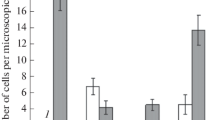Abstract
Adhesion of the hydrophilicLeptospira biflexa serovarpatoc 1 (L. patoc) was consistently greater on inert hydrophobic surfaces than on hydrophilic surfaces (glass and plastic). When inert substrata were coated with fetal calf serum (FCS) or bovine serum albumin fraction V (BSA), however, surface hydrophobicity was reduced compared to untreated surfaces, but adhesion ofL. patoc increased. The mechanism of adhesion at protein-coated surfaces is likely to be different than that at untreated surfaces, but it is suggested that the adhesion is nonspecific, as the level of adhesion is similar for different protein coatings. Increased adhesion to FCS- and BSA-coated surfaces was apparently not associated with substrate utilization (scavenging of fatty acids) from the coatings, as essentially fatty acid-free BSA-coated surfaces had similar levels of adhesion. The presence of FCS in the diluent lowered the adhesion ofL. patoc regardless of the original nature of the substratum. This may result from the mutual repulsion of the bacterium and the substratum caused by the exclusion volumes of similar macromolecules adsorbed to both surfaces from the FCS solution.
Similar content being viewed by others
References
Absolom DR, Lamberti FV, Policova Z, Zingg W, Van Oss DJ, Neumann AW (1983) Surface thermodynamics of bacterial adhesion. Appl Environ Microbiol 46:90–97
Baier RE (1980) Substrata influences on adhesion of microorganisms and their resultant new surface properties. In: Bitton G, Marshall KC (eds) Adsorption of microorganisms to surfaces. Wiley-Interscience, New York, pp 59–104
Dahlbäck B, Hermansson M, Kjelleberg S, Norkrans B (1981) The hydrophobicity of bacteria—an important factor in their initial adhesion at the air-water interface. Arch Microbiol 128:267–270
Dawson MP, Humphrey BA, Marshall KC (1981) Adhesion: a tactic in the survival strategy of a marine vibrio during starvation. Curr Microbiol 6:195–199
Dexter SC (1979) Influence of substratum critical surface tension on bacterial adhesion—in situ studies. J. Colloid Interface Sci 70:346–354
Fletcher M (1976) The effects of proteins on bacterial attachment to polystyrene. J Gen Microbiol 94:400–404
Fletcher M, Loeb GI (1979) The influence of substratum characteristics on the attachment of a marine pseudomonad to solid surfaces. Appl Environ Microbiol 37:67–72
Fletcher M, Marshall KC (1982) A bubble contact angle method for evaluating substratum interfacial characteristics and its relevance to bacterial attachment. Appl Environ Microbiol 44:184–192
Henry RA, Johnson RC (1978) Distribution of the genusLeptospira in soil and water. Appl Environ Microbiol 35:492–499
Humphrey BA, Kjelleberg S, Marshall KC (1983) Responses of marine bacteria under starvation conditions at a solid-water interface. Appl Environ Microbiol 45:43–47
Johnson RC, Harris VG (1967) Differentiation of pathogenic and saprophytic leptospires. I. Growth at low temperatures. J Bacteriol 94:27–31
Jones GW (1984) Adhesion to animal surfaces. In: Marshall KC (ed) Microbial adhesion and aggregation. Springer-Verlag, Berlin, pp 71–84
Kazarov LB (1970) Degradation of the erythrocyte phospholipids and haemolysis of the erythrocytes of different animal species by leptospirae. J Med Microbiol 3:29–37
Kefford B, Kjelleberg S, Marshall KC (1982) Bacterial scavenging: utilization of fatty acids localized at a solid-liquid interface. Arch Microbiol 133:257–260
Kefford B, Marshall KC (1984) Adhesion ofLeptospira at a solid-liquid interface: a model. Arch Microbiol 138:84–88
Kjelleberg S, Humphrey BA, Marshall KC (1983) Initial phases of starvation and activity of bacteria at surfaces. Appl Environ Microbiol 46:978–984
Lewin RA, Lounsbery DM (1969) Isolation, cultivation and characteristics of flexibacteria. J Gen Microbiol 58:145–170
Magnusson KE, Stendahl O, Tagesson C, Edebo L, Johansson G (1977) The tendency of smooth and roughSalmonella typhimurium bacteria and lipopolysaccharide to hydrophobic and ionic interaction as studied in aqueous polymer two-phase systems. Acta Pathol Microbiol Scand Sect B 85:212–218
Maroudas NG (1975) Polymer exclusion, cell adhesion and membrane fusion. Nature Lond 254:695–696
Marshall KC, Cruickshank RH (1973) Cell surface hydrophobicity and the orientation of certain bacteria at interfaces. Archiv Mikrobiol 91:29–40
Ofek I, Beachey EH (1980) General concepts and principles of bacterial adherence in animals and man. In: Beachey EH (ed) Bacterial adherence. Chapman and Hall, New York, pp 3–26
Rosenberg M, Gutnick D, Rosenberg E (1980) Adherence of bacteria to hydrocarbons: a simple method for measuring cell surface hydrophobicity. FEMS Microbiol Lett 9:29–33
Tanford C (1973) The hydrophobic effect: formation of micelles and biological membranes. John Wiley & Sons, New York
Zisman WA (1964) Relation of the equilibrium contact angle to liquid and solid constitution. Advan Chem 43:1–51
Author information
Authors and Affiliations
Rights and permissions
About this article
Cite this article
Kefford, B., Marshall, K.C. The role of bacterial surface and substratum hydrophobicity in adhesion ofLeptospira biflexa serovarpatoc 1 to inert surfaces. Microb Ecol 12, 315–322 (1986). https://doi.org/10.1007/BF02098572
Issue Date:
DOI: https://doi.org/10.1007/BF02098572




